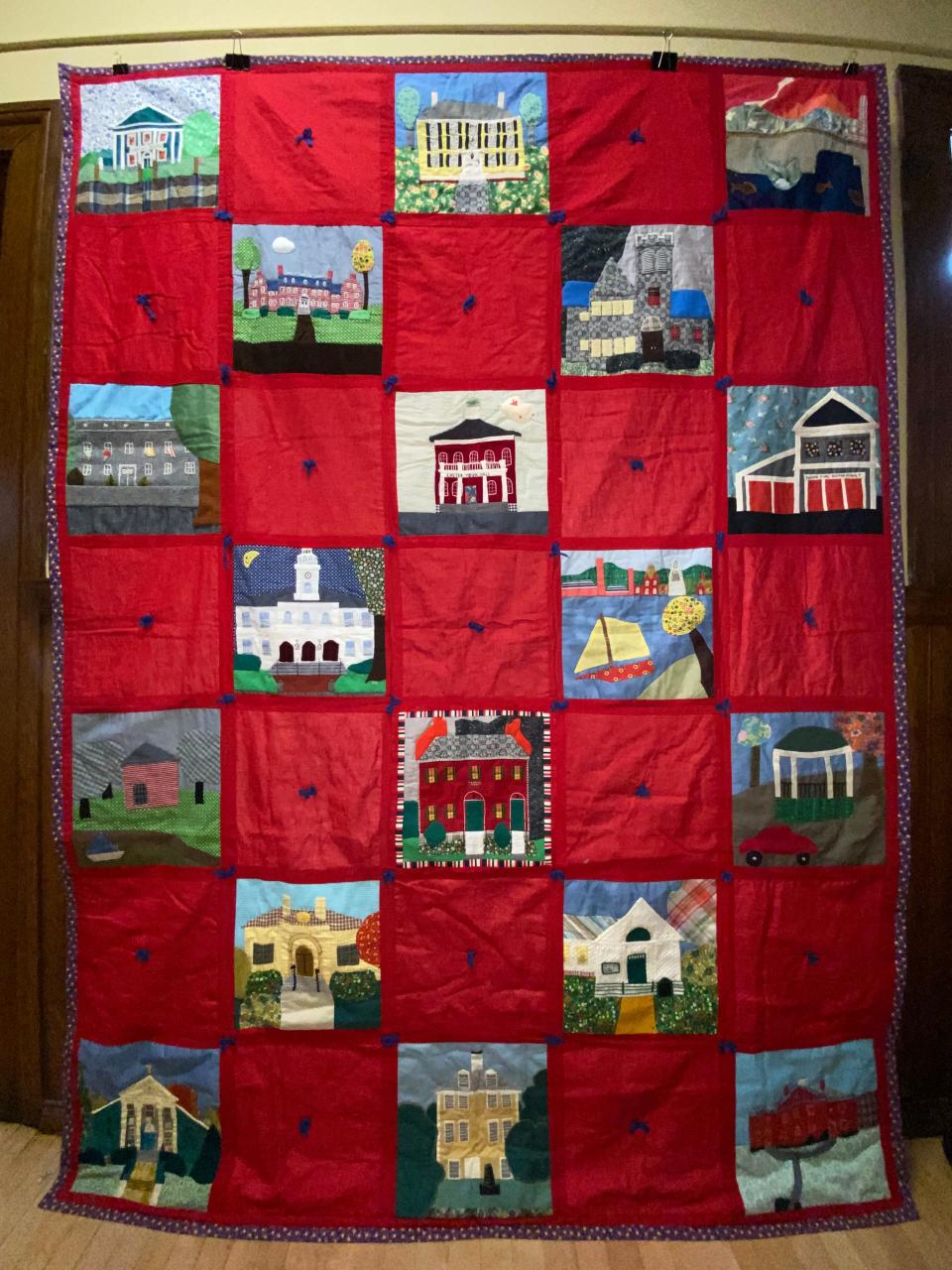Historically Speaking: Town quilt offers a snapshot of Exeter's past
Eight years ago, a local family donated a quilt to the Exeter Historical Society. Vivid red blocks are interspersed with appliqued scenes from Exeter. The colors are bright and the fabric, although giving off a decidedly colonial vibe, can best be described as 1970s “vintage.” The donors knew very little about the quilt, except that they’d won it in a raffle during the bicentennial celebrations. This left the Historical Society scrambling to find out more about the quilt’s origins.
Exeter’s Bicentennial Commission was organized and officially recognized in 1975. It would take a great deal of planning to hold all the events. There were reenactments, an “Old Home Days” festival, school projects, a parade, and Arthur Fiedler and the Boston Pops were coming for a concert on the Phillips Exeter Academy playing fields.

There was a lot to do! The town (and the nation) needed a celebration after the previous decade of political and social unrest. The very fact that the bicentennial celebrations were presided over by President Gerald Ford, who had become president without running in a presidential election, strengthened the mood that our system of government was solid even when scandal and political shenanigans seemed to be pulling things apart. Maybe the bicentennial would serve as a balm.
Of the many subcommittees on the Exeter Bicentennial Commission was the Arts & Crafts committee led by Kitty Spitzer. One of the ideas brought to the chairman (Rev. Charles Calcagni, of the Exeter Congregational Church) was a town quilt. In a letter he drafted to the Board of Selectmen, Calcagni pitched the idea to the town. “I’m writing to say that they would like very much to make available to our community the creation of a town quilt. This quilt would depict scenes, buildings, and life here in Exeter and to be worked on by many of our townspeople. However, before such a project is undertaken, they would like to be assured that (1.) the town would accept this gift, and (2.) for a period of time it might be displayed somewhere in the town offices, i.e., say the Nowak Room. Needless to say, this request is predicated on the assumption that it would be a fine work of art worthy of being hung.”
Historically Speaking: A trial of parking meters in Exeter
Other towns made their own bicentennial quilts – North Hampton and Rye had volunteers stitching that summer, and the Kensington library made a needlepoint rug depicting the state flowers of the 13 original colonies. Town quilts had quite a run in 1975.
At some point, and here there is a loose thread in the story, instead of the project becoming part of the Arts & Crafts subcommittee of the Exeter Bicentennial Commission, it was instead adopted by the Women’s Alliance of the First Unitarian Society of Exeter. They traced their origins to 1854 when they called themselves the “Ladies Social Circle.” In 1893, they changed their name to “Ladies Sewing Society” to reflect the work they did making sheets, towels, and bed gowns for the newly established Exeter Hospital Guild. They joined the National Alliance of Unitarian and other Liberal Christian Women in 1900. As a social and fundraising group of the church, they had considerable fiduciary power.
Historically Speaking: Hollywood comes to Exeter
By the 1970s, however, church attendance was far from what it had once been. The women of the Alliance still worked to fundraise for the church budget. The quilt seemed like an excellent way to meet this goal. It could be displayed around town and raffled at the annual Candy Cane Fair in December. The members stitched throughout the fall of 1975, creating 18 scenes of Exeter. They included four churches – the Congregational Church, St. Michael Catholic Church, Phillips Church and, naturally, the First Unitarian Society. In 1975, some of the landmarks we know today were used for different purposes. Thus, the Exeter Historical Society was still in the red brick building at 27 Front Street and the yellow library building was still the public library. The fire department was located in the old courthouse on Court Street (today it is our Senior Center). Also making appearances are the powder house, bandstand, town hall and the Exeter Inn. The American Independence Museum – then known as the Society of the Cincinnati – is featured and the Dudley house, only recently saved from destruction with the creation of the downtown historic district, stands top and center.
Each of the 12-inch squares are appliqued and embroidered with great skill. Fabric colors are used to match, or at least complement, the building materials. The embroidery work in the Great Dam scene, particularly the fish, is extraordinary. After publicizing the quilt, it was raffled as intended, helping to raise $1,500 that the Women’s Alliance donated to the church.
This quilt, along with others, will be on display at the Exeter Historical Society during the months of May and June. A credit to the women who produced them, and a historical snapshot of the town as depicted in fiber art.
Barbara Rimkunas is the curator of the Exeter Historical Society. Support the Exeter Historical Society by becoming a member. Join online at www.exeterhistory.org.
This article originally appeared on Portsmouth Herald: Historically Speaking: Town quilt offers a snapshot of Exeter's past

